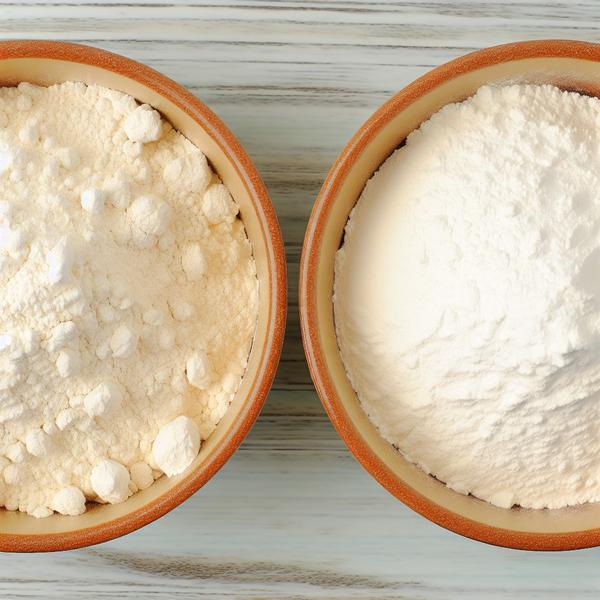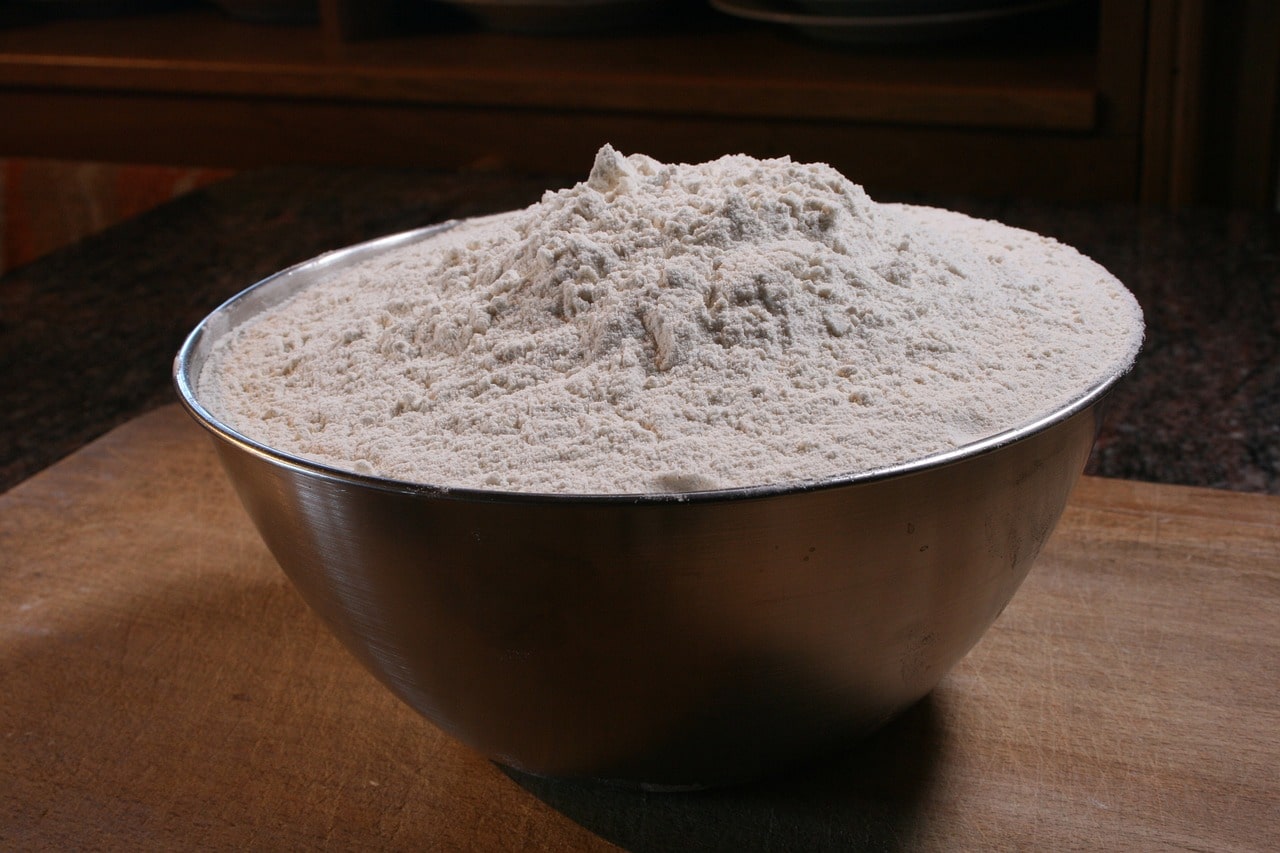Is All Purpose Flour the Same as Plain Flour? (NOPE, It's Not!)

Tired of being left in the dark about flour types?
Wondering if all purpose flour and plain flour are just two names for the same thing?
I get it, the confusion can be overwhelming.
You might be thinking, "What if I ruin my recipe? What if I waste money on the wrong flour?" 😟
Take a deep breath, because I've got you covered.
Let's dive into the world of flour and uncover the truth together.
Substituting All-Purpose Flour: What's the Difference?
When substituting all-purpose flour, you ought to consider the difference in texture and protein content. All-purpose flour is versatile and suitable for various baking tasks, while plain flour is best for delicate pastries and cakes. Substituting may affect taste and texture, so adjustments may be needed.
Listen up, I've got something to tell you:
Plain flour and all-purpose flour might seem the same, but they're not.
Let me break it down for you.
All-purpose flour is a go-to because it works in so many recipes for all kinds of baked goods.

But if you want delicate pastries and cakes, plain flour is your jam with its finer texture. 🍰
Not only that, but plain flour is also more coarse, perfect for rustic breads and pastries.
So, if you're going for that homemade country-style vibe, go ahead and use plain flour.
Now, both flours are made from a mix of hard and soft wheat, and they have medium to low protein content.
That means they won't make your baked goods rise as much as high-protein flours like bread flour.
But hey, sometimes we want a fluffy cake, and that's okay too.
Now let's talk substitutions.
No worries if you can't find plain flour!
You can use all-purpose instead, just know that it might change the texture and taste a little bit.
Be prepared for a slight difference.
On the other hand, if all you have is all-purpose flour and you need plain flour, don't panic...
You can make your own substitute.
Here's how you do it:
- Get some all-purpose flour.
- Add an extra ingredient like cornstarch to give it the fine texture of plain flour.
- And voila! You're good to go.
Every flour has its quirks, so when you swap one out for another, adjust the liquid and leavening agents accordingly.
And unless your recipe specifically asks for self-raising flour, leave it on the shelf.
No bread flour?
No problem!
Just replace it with all-purpose flour, but take out one teaspoon and add vital wheat gluten to make up for it.
Ultimately, understanding the differences between flours and making the right adjustments will lead you to baking greatness. So get out there and create some delicious treats!
Main points I'll expand upon further down this article:
- Use a digital scale or measuring cups to accurately measure flour.
- Sifting flour depends on recipe instructions and can be done before or after measuring.
- Be gentle when working with pastry flour to avoid a tough texture.
- Add 1/2 teaspoon of baking powder to every 100g of plain flour to make self-rising flour.
- Bleached flour creates softer products but lacks fiber found in whole wheat flour.
But wait, there's more to flour versatility!
Did you know that there's a type of flour that already has baking powder mixed in?
This magical flour is known as self-raising flour, and it eliminates the hassle of adding leavening agents separately.
So if you thought plain and all-purpose flour were adaptable, just imagine the possibilities with self-raising flour...
Let's dive into this convenient option for your baking adventures.
The Versatility of Self-Raising Flour: What Sets It Apart From All-Purpose Flour?
Self-raising flour is the go-to choice for those looking to streamline their baking process.
With its pre-mixed baking powder, it eradicates the tedious task of adding leavening agents separately.
Save yourself time and effort by opting for self-raising flour – a versatile option that can be used in a wide array of recipes.

However, fear not if plain flour is all you have at hand!
Transform it into self-raising flour with the simple addition of raising agents.
This convenience makes self-raising flour a preferred staple for many bakers. Don't miss out on the ease and efficiency it brings to your culinary endeavors.
Step-by-step Process for Transforming All-Purpose Flour to Self-Rising Flour
Converting plain flour to self-rising flour is easy.
First, you need to measure the flour accurately.
A digital scale is ideal, but a measuring cup works too.
Just fluff up the flour and level it with a knife. Whether or not you sift depends on the recipe instructions.
If it says "sifted flour," sift it before measuring.
If it says "flour, sifted," sift it after measuring.
Be gentle when handling pastry flour; it can turn tough if you're rough.
To make self-rising flour, add half a teaspoon of baking powder for every 100g of flour.
For 200g of plain flour, add 1 teaspoon of baking powder.
That's it!
With these simple steps, you'll have self-rising flour ready to go for your baking endeavors. 😊
And now, let's explore the different types of flour available and their specific uses in various baking recipes!
The Impact of Bleaching on All-Purpose Flour: Texture, Color, and Health Considerations
| Aspect | All-Purpose Flour | Plain Flour |
|---|---|---|
| Texture | Softer and lighter than whole wheat flour. | Similar to all-purpose flour, but may vary depending on the type and brand. |
| Color | Lighter color due to bleaching process. | May have a slightly darker color depending on the type and brand. |
| Health Considerations | Lower fiber content due to bleaching process. | May contain more nutrients and fiber, depending on the type and brand. |
| Recommended for | Versatile in baking various recipes, including cakes, cookies, and pastries. | Suitable for a wide range of recipes, including bread, cookies, and batters. |
| Specialty Alternatives | 00 Flour from Italy provides a smoother and lighter consistency for pasta and pizza dough. | N/A |
Are you curious if all-purpose flour and plain flour are the same?
Let me break it down for you, my friend.
So, here's the deal:
When you bleach all-purpose flour, it not only changes the texture but also the color of your baked goods. It takes them to a whole new level of softness, like a fluffy cloud! 💫
Now, who wouldn't want that kind of delightful experience?
The thing to bear in mind is that when flour undergoes bleaching, it actually loses some of its fiber content.
And as we all know, fiber is crucial for our health.
So as you make your decision, be sure to weigh the importance of fiber for your overall well-being.
But let's talk about certain recipes, such as pasta or pizza dough.
For these, experts suggest using 00 flour from Italy.
Now, you might wonder why this particular flour is recommended.
Well, let me tell you - it has a wonderfully smooth and light consistency that will take your creations to a whole new level of excellence.
Understanding the Nutritional Value of All-Purpose Flour and Plain Flour
All-purpose flour and plain flour differ in protein content, affecting the structure of baked goods. All-purpose flour has 9-11% protein, while plain flour is low-protein, ideal for delicate treats. All-purpose flour has 455 calories per cup and is enriched with minerals.
Let's dig deeper into the nutritional value of all-purpose flour and plain flour, so you can make an educated decision for your baking endeavors.
All-purpose flour is like a jack-of-all-trades in the baking world—it's versatile and works well in various recipes.
However, one key difference between all-purpose flour and plain flour is their protein content.
All-purpose flour usually contains around 9% to 11% protein, which means it has more gluten. And why does that matter?
Well, gluten gives baked goods a denser texture.
So, if you want your bread to have a chewy crust or your bagels to have a satisfying bite, all-purpose flour is your guy.
On the flip side, plain flour is low in protein, making it perfect for delicate treats like pastries and cakes.
With less gluten than all-purpose flour, using plain flour will give your creations a lighter and fluffier texture.
Now let's talk about the nutritional content. A cup of all-purpose flour sets you back by around 455 calories.
But keep in mind that this calorie count could change depending on how it is combined with other ingredients in a recipe.
Both all-purpose flour and plain flour are good sources of carbohydrates that provide energy to your body—something worth noting!
Did you know that there are specialty flours available for specific baking needs?
Bread flour, for instance, is great for making crusty bread, while cake flour is specially crafted for those scrumptious cakes.
These specialty flours come with specific requirements, ensuring optimal results for your baked goods.
Ultimately, the choice between all-purpose flour and plain flour depends on what you're aiming for in terms of texture and purpose.
All-purpose flour brings versatility and structure to your culinary creations, whereas plain flour adds lightness and tenderness.
Why not experiment with both and uncover the magic they each bring to your kitchen?
And that's all for today folks.
You've reached the end of my blog post, and now I'd love to know your thoughts. Did you enjoy reading it? I always put in a tremendous amount of effort to create informative and comprehensive blog posts. It takes up a significant portion of my time, but I find it immensely rewarding. If you could help me out by clicking on any of the social sharing icons to share this blog post with others, I would genuinely appreciate it. Thank you so much!
Until next time,
-Bianca Rossi